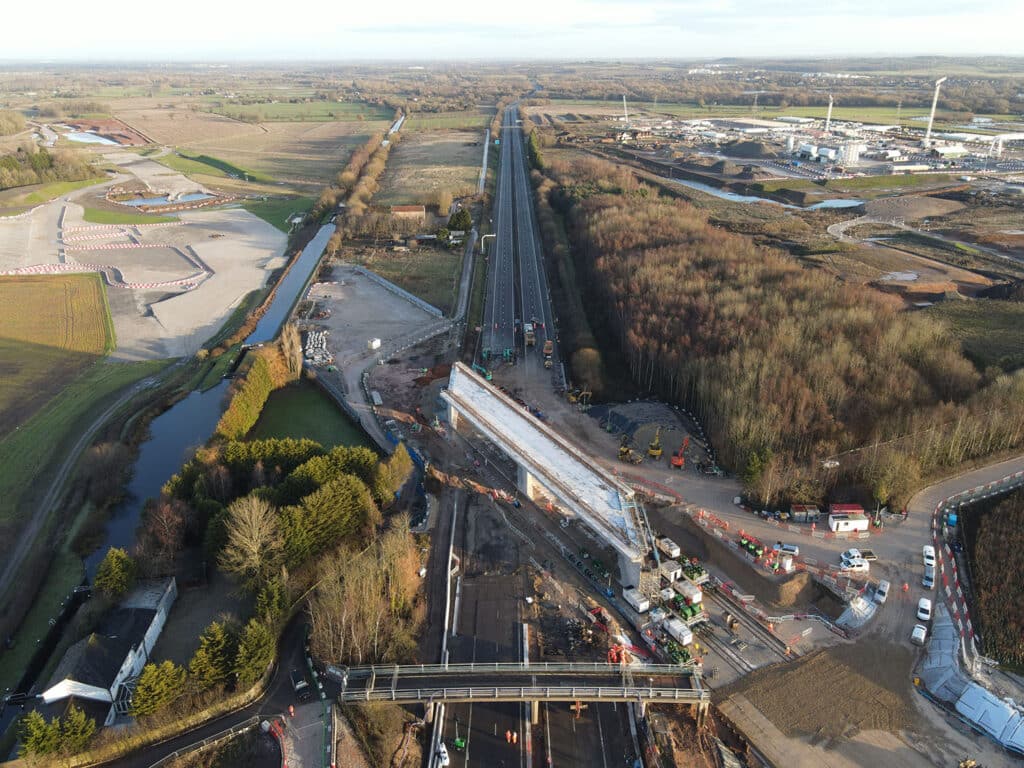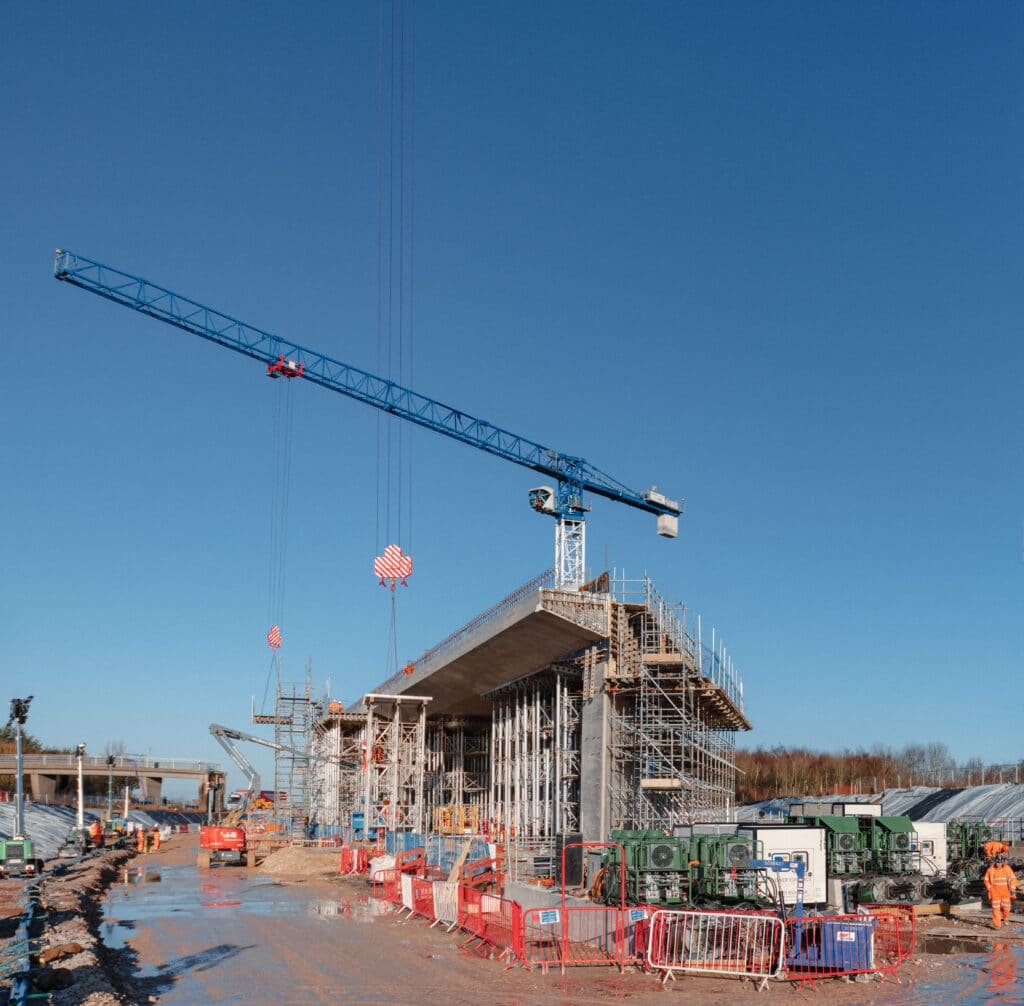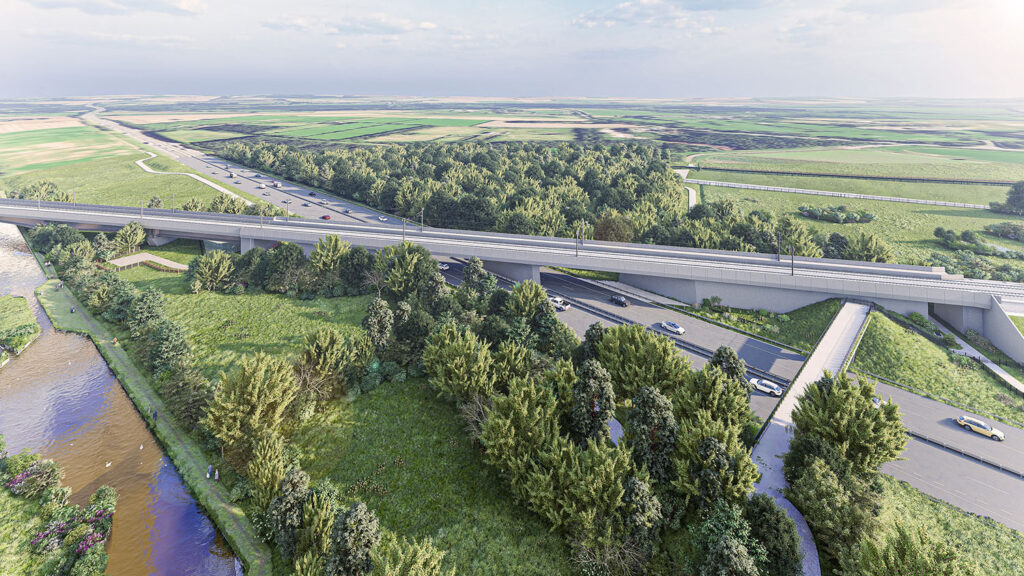The world’s longest bridge box slide
Over the Christmas period 2022 the Marston Box Bridge spanning 86 metres and weighing 12,600 tonnes was slid into place across one of the UK’s busiest motorways, the M42 in Warwickshire. It was a world first.
The Marston Box Bridge forms a critical part of the HS2 Main Works Civils Contract Lots N1 and N2 being delivered by Balfour Beatty VINCI. On completion the structure will carry HS2 trains over the M42 motorway north to Crewe and south to Birmingham Curzon Street or to the interchange station at Solihull, Old Oak Common Station and London Euston Station.
Designed by SYSTRA structural engineers, using innovative technology to reimagine the baseline design, with support from our joint venture partner Mott MacDonald and specialist consultant Freyssinet, the solution supports HS2’s objectives to minimise disruption to road users, reduce the impact of construction on local communities, and demonstrate environmental stewardship.
The dramatic operation took 40 hours, at a speed of 4 metres per hour, during a 10-day closure of the motorway between Junctions J9 and J10 (northbound and southbound).
“The Marston Box slide was a great example of what can be achieved when we work collaboratively and as one team. This complex and challenging puzzle was solved thanks to lots of different teams coming together, each bringing their own area of expertise and experience. It’s certainly a career highlight for me, as I’m sure it is for many others who contributed to this impressive engineering feat.”
Sasan Ghavami, Balfour Beatty VINCI’s Project Director North Main Line


A dramatic reduction in disruption and carbon
By adopting the box slide method, the project significantly enhanced the safety of both workers and drivers, minimising work conducted alongside live motorway lanes. Furthermore, this pioneering approach utilised construction efficiency, leading to considerable time and cost savings.
The project prioritised mitigating disruptions typically associated with traditional construction methods. Instead of enduring protracted lane restrictions and closures, the box slide technique required only two road closures. The approach minimised inconvenience for road users, alleviated traffic congestion, and mitigated the impact on surrounding communities.
Delivering social, environmental and commercial benefits
The project successfully eliminated two years of restrictions and concluded a full day ahead of schedule, significantly reducing disruptions for motorists and ensuring streamlined project delivery. These accomplishments resulted in substantial cost savings and heightened project efficiency.
As part of the key project gateway lifecycle assessment (LCA) Balfour Beatty VINCI evaluated that the revised design improved carbon and materials efficiency by decreasing steel and concrete quantities and removing numerous pot bearings of the initial design. In addition, the off-site construction reduced the closure of the M42 from 18 months in the initial design to only 10 days avoiding significant carbon emissions from the M42 diversion and traffic congestion. The carbon savings were evaluated as having avoided 2230 tCO2, a 25% reduction from the baseline scheme design.
Qualitatively, the project captured the imagination of the public and media, with the video of the slide becoming the BBC’s “most watched” during the festive period. This recognition not only showcased the slide’s spectacle but also inspired appreciation for the field of engineering in the general public.
Revolutionising bridge placement
The Marston Box Rail Bridge Box Slide represented ground-breaking innovation by redefining infrastructure construction practices. This visionary project emerged from a desire to revolutionise traditional bridge placement methods, resulting in the UK’s inaugural box bridge slide and a world record for the longest slide. Through collaboration, cutting-edge engineering and sustainability, the box slide established a new benchmark for the industry.
The solution, an alternative design for the M42 Marston Box Rail Bridge, was put forward by the Mott MacDonald SYSTRA Design Joint Venture to reconsider the structure, working closely with Freyssinet on the interfaces between temporary and permanent works to ensure the bridge’s 120-year design life. There was a multitude of tolerances to deal with, both in terms of how the structure would settle and the impact on headroom for the M42 motorway and the high-speed rail line above it.

An enduring legacy
Looking toward the future, SYSTRA and their partners have identified crucial next steps to ensure enduring impact and continued progress. Plans are underway to expand the implementation of the box slide method and two additional box slides are Incorporate in delivery of Lots N1 and N2 of HS2; demonstrating the viability and advantages of this innovative construction technique.
Collaboration and knowledge sharing remain the cornerstones of the operation’s success. By fostering strategic partnerships and sharing expertise with industry stakeholders, the project seeks to inspire similar breakthroughs in infrastructure construction. The box slide exemplifies the achievements that can be realised through collaboration, teamwork, and the amalgamation of diverse talents and expertise.
The box slide set a new standard for construction practices by optimising traffic flow during large-scale infrastructure projects.
 Australia
Australia  Brazil
Brazil  Canada
Canada  China
China  Denmark
Denmark  France
France  India
India  Indonesia
Indonesia  Ireland
Ireland  Italy
Italy  Malaysia
Malaysia  New Zealand
New Zealand  Norway
Norway  Poland
Poland  Saudi Arabia
Saudi Arabia  Singapore
Singapore  South Korea
South Korea  Sweden
Sweden  Taiwan
Taiwan  Thailand
Thailand  United States
United States  Vietnam
Vietnam